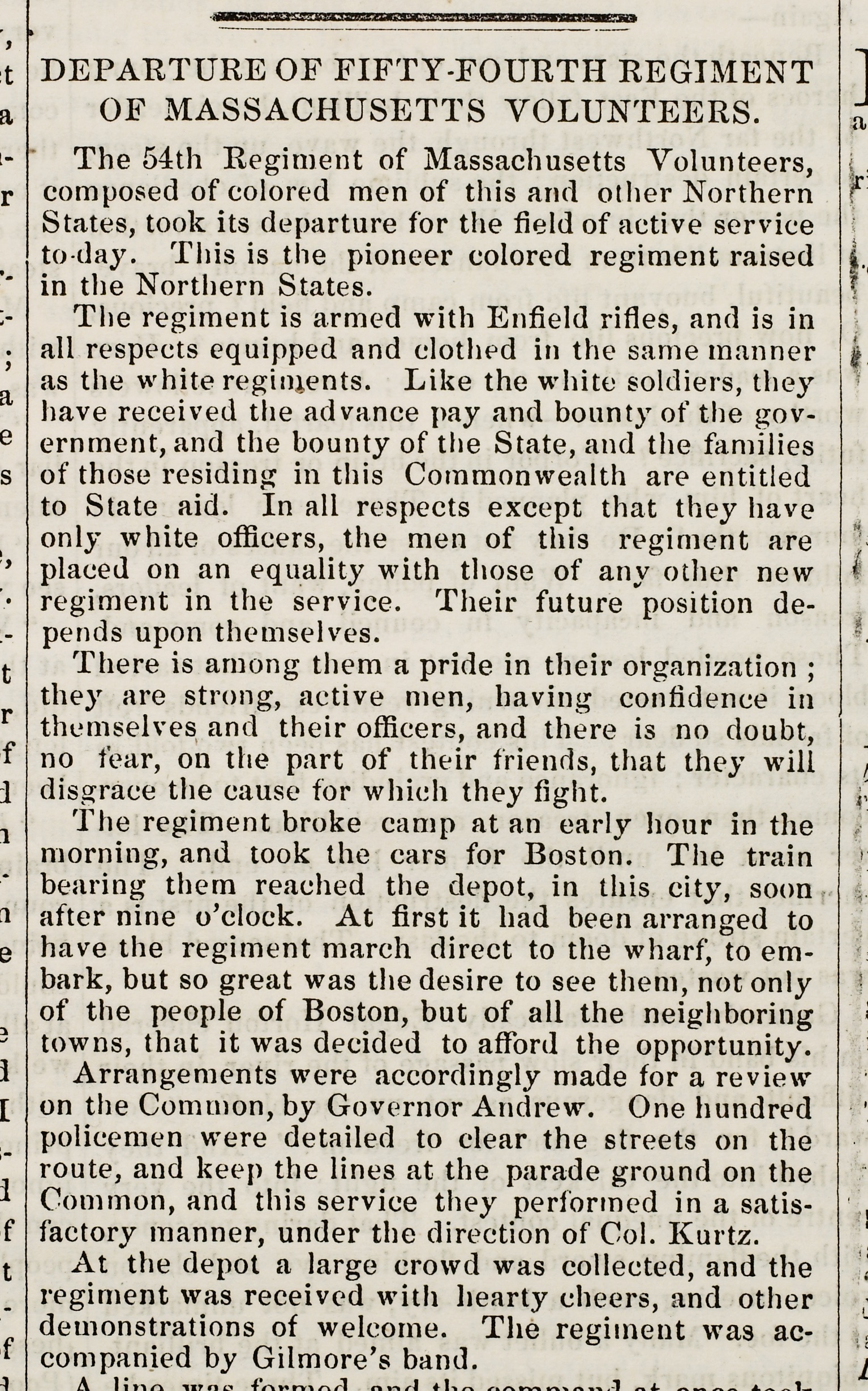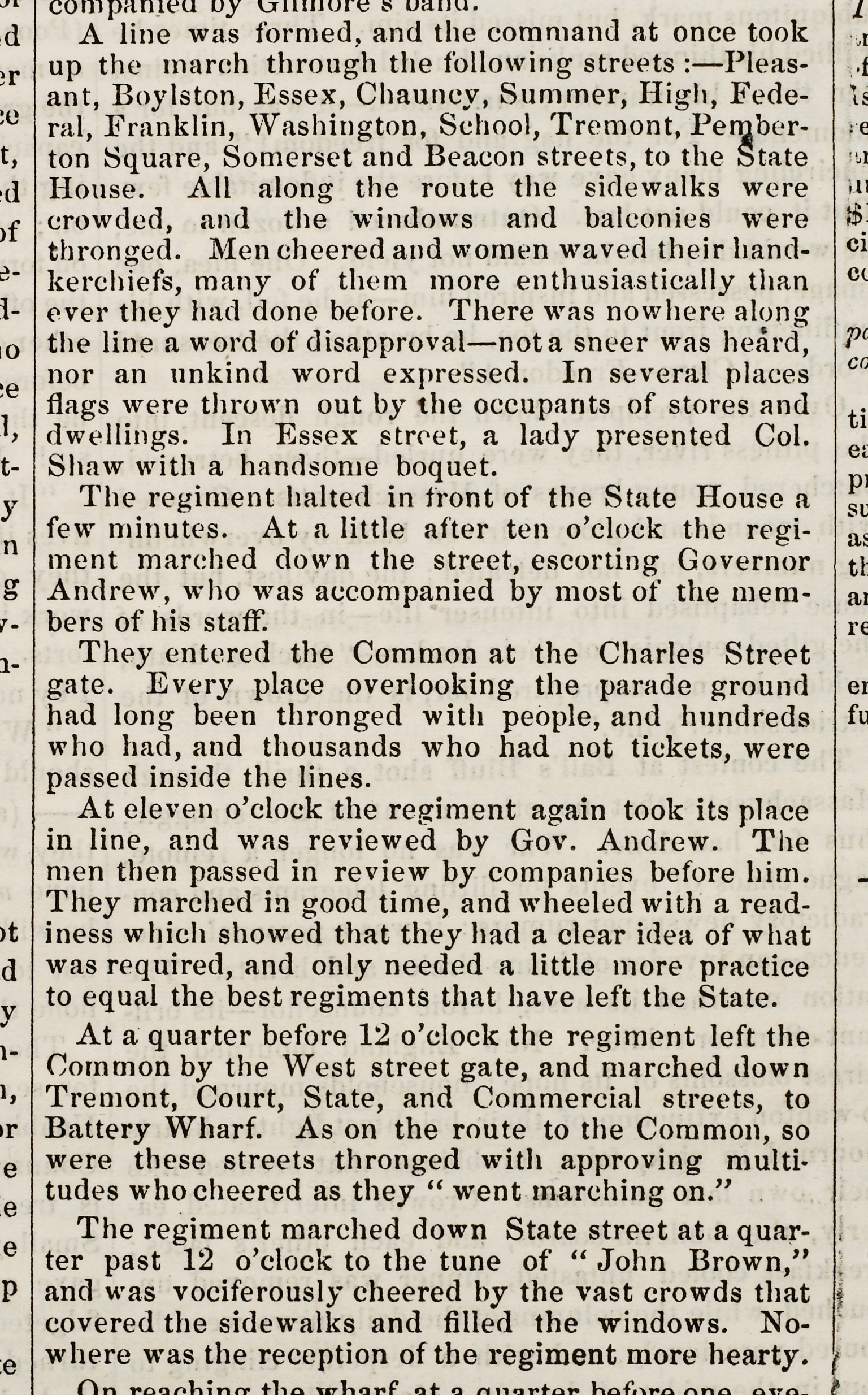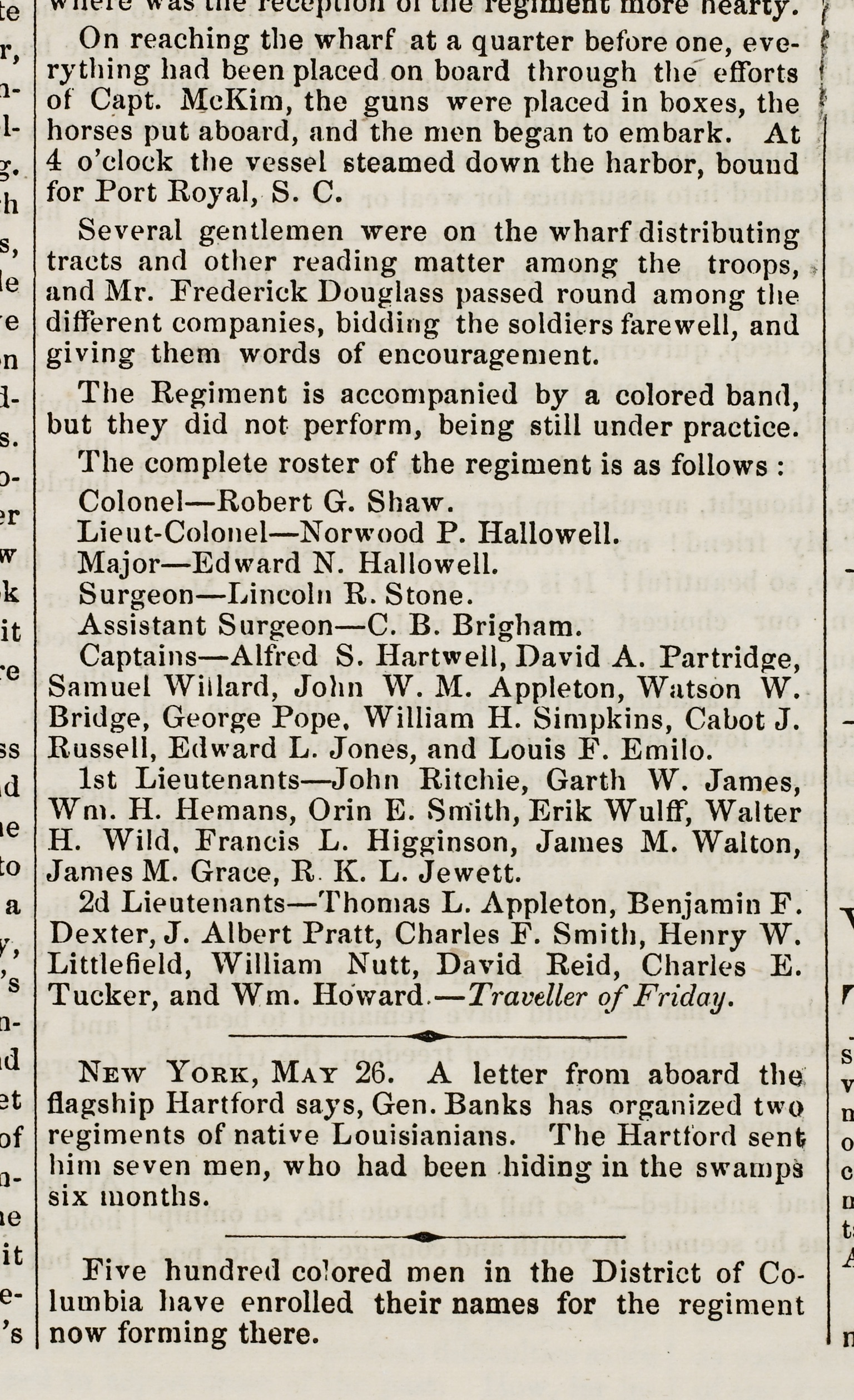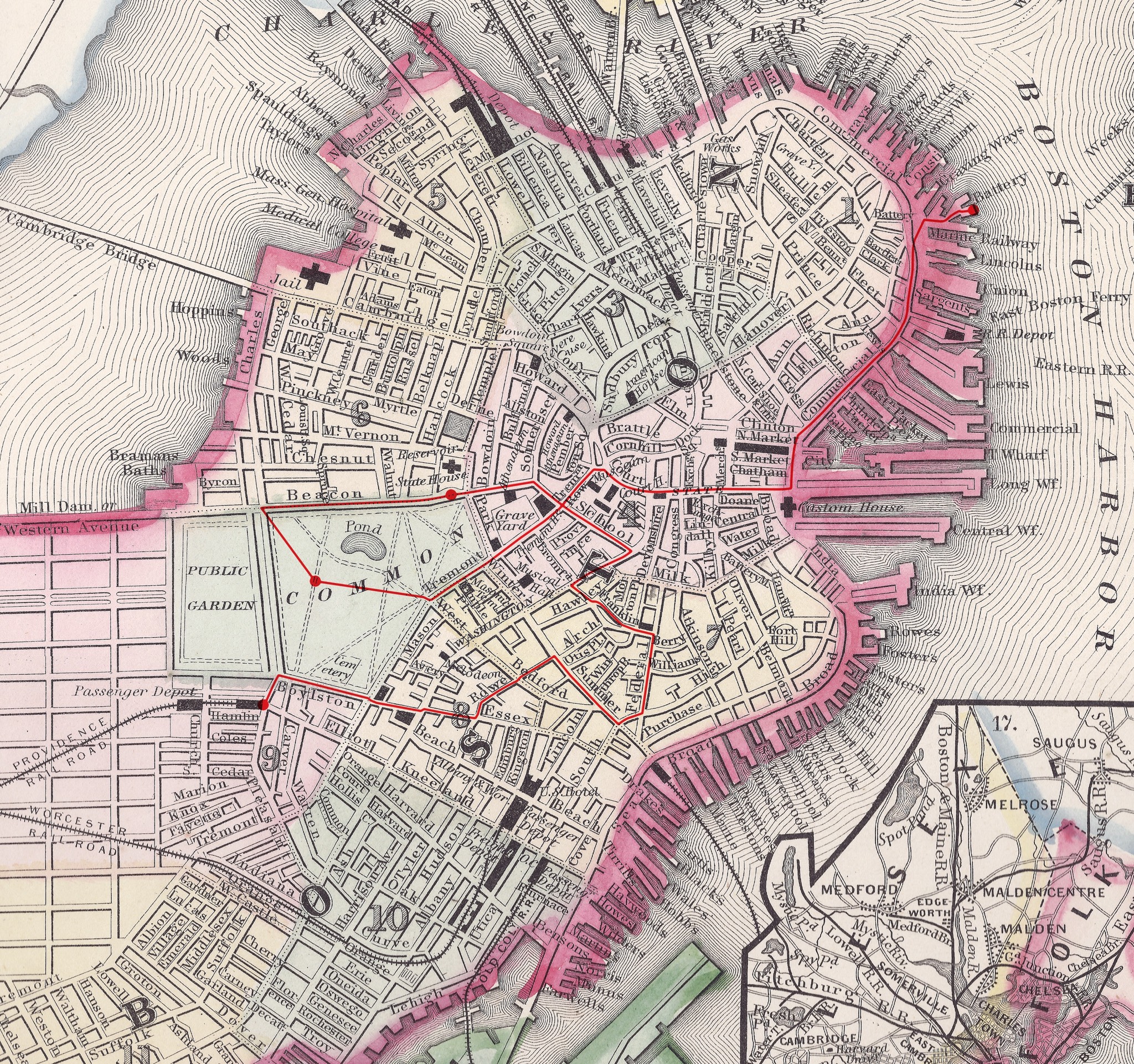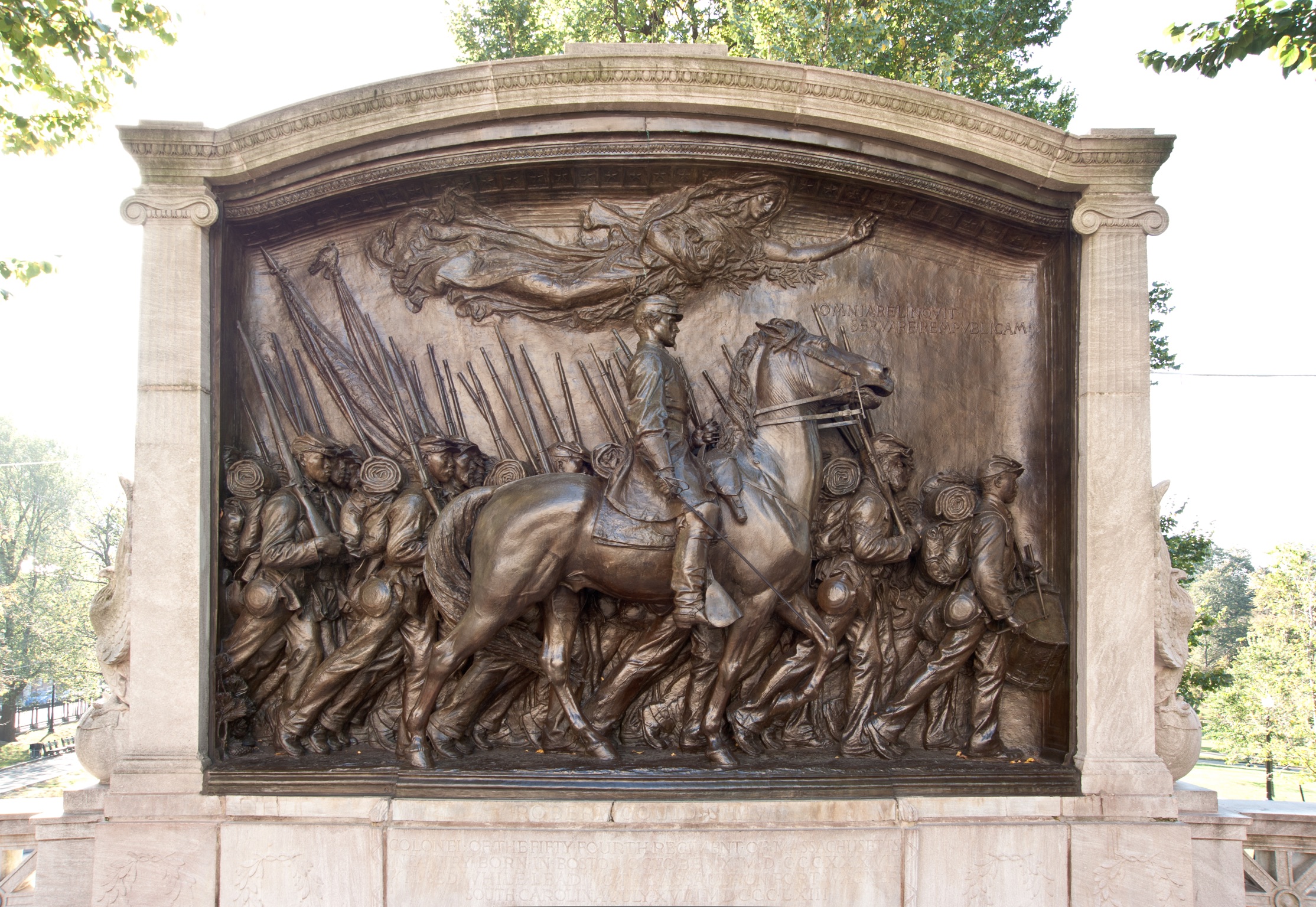Hold History
The 54th Massachusetts Regiment
Ben’s Collection of Rare Documents and Historic Newspapers
Departure of the 54th Regiment
Departure of the 54th Regiment of Massachusetts Volunteers in the June 5, 1863 issue of The Liberator.
Colonel Shaw, Sergeant Carney, and the 54th Massachusetts
On Boston Common, at the corner of Beacon and Park streets, stands what many consider to be the greatest public sculpture in the United States – The Shaw 54th Regiment Memorial. The high-relief bronze memorial created by sculptor Augustus Saint-Gaudens honors Colonel Robert Gould Shaw and the African American soldiers of the 54th Massachusetts Regiment. It took Saint-Gaudens 14 years to complete his tribute and the unveiling took place on Decoration Day in 1897. Thirty-four years earlier in January 1863, the same month that President Lincoln signed the Emancipation Proclamation, Massachusetts Governor John A. Andrew sought to create an all-black regiment as part of his quota of troops from the Commonwealth of Massachusetts. This unit, known as the 54th Massachusetts Volunteer Infantry Regiment, would become the first all-black military unit raised in the North during the Civil War. Governor Andrew elected to commission white officers with military experience and firm anti-slavery principles to lead the unit. He wrote a letter to Francis Shaw, an abolitionist with Boston ties, about his plans and outlined his reasons for offering the command of the 54th to his son Robert Gould Shaw. Governor Andrew enclosed a letter to Robert Gould Shaw and asked his father to be sure he received it. At this time, Robert was a captain with the 2nd Massachusetts Infantry and in winter camp in Stafford Courthouse, Virginia. Robert Gould Shaw had enlisted when the war began in 1861 and taken part in several battles including Cedar Mountain and Antietam. Francis George Shaw chose to hand deliver Governor Andrew’s letter to Robert and visited him in Virginia.
Robert Gould Shaw initially chose to decline Governor Andrew’s offer but after more consideration and a desire to please his mother, Sarah Blake Sturgis Shaw, he agreed to accept the command and serve as colonel of the 54th Massachusetts Regiment. A few days later, Robert announced his engagement to Annie Haggerty. The two had met just before the war when Susanna, one of Robert’s sisters, invited Annie to a small gathering of family/friends attending the opera. They had kept up a steady correspondence when Robert was away fighting for the Union. Robert returned to Boston on February 15 and effort began in earnest to both recruit and train men for the 54th. By March 1863, Colonel Robert Gould Shaw had become a celebrity in Boston, attending dinner parties and gatherings where he delivered short speeches about recruiting and the progress of the black soldiers in camp.
Learn the story behind one of those speeches from an article in the March 13, 1863 issue of The Liberator.
Robert did take a short break for his wedding and honeymoon. Colonel Robert Gould Shaw and Anna Kneeland Haggerty were married on May 2, 1863 in The Church of the Ascension on Fifth Avenue and Tenth Street in New York City. They spent four relaxing days in the Berkshires of Massachusetts before Shaw learned that he’d have to return before the week was out as the Governor had ordered his regiment to leave for the south in less than three weeks. Departure day was eventually set for May 28, 1863. On that day, at 9 am, 1,007 black soldiers and 37 white officers of the 54th Massachusetts Regiment began a parade march through the streets of Boston in full dress uniform. Colonel Robert Gould Shaw rode at the head of the column. Large crowds turned out to see the regiment off. In the reviewing stands and peering from balconies along the parade route were such dignitaries as Governor John A. Andrew, William Lloyd Garrison, Wendell Phillips, and Frederick Douglass whose son Lewis Douglass was a member of the 54th. Robert Gould Shaw’s family, including his mother, four sisters and his wife, stood on the second-floor balcony of the Sturgis home located at 44 Beacon Street. When Colonel Shaw arrived at their location, he looked up and raised his sword to his lips. His seventeen-year-old sister Ellen, recalling how she felt about her brother Rob at that very moment, later wrote “his face was as the face of an angel and I felt perfectly sure he would never come back.”
The balcony at 44 Beacon Street where Colonel Shaw’s family stood.
After the parade, the men said goodbye to their families, boarded their transport ship and headed for South Carolina. On June 3, the transport arrived at the port of Hilton Head. A week later, the 54th took part in a raid that involved burning the town of Darien, Georgia – something that upset Colonel Shaw greatly. When Shaw learned in late June that his black troops would receive pay of only $10 per month instead of the $13 per month they had been promised (the same as white troops), he protested personally. The men vowed to accept no pay at all until the issue was resolved – and it eventually was, but not until nearly 18 months passed. Concerned that his men might not see any real action and have the chance to prove themselves, Colonel Shaw wrote to General George Strong on July 6 and asked that the 54th Massachusetts be placed under his command. This occurred a few days later and the regiment performed very honorably in its first major engagement at James Island, South Carolina on July 16. Shortly after the battle, the 54th began a two-day excursion with only the hardtack they carried in their packs for food. Marching through mud flats and marsh, through thunderstorms and in the blazing sun, with the aid of two transports they made it to Morris Island on the afternoon of Saturday, July 18, 1863. Here, the heavily fortified Confederate Fort Wagner was located. The fort had been under Union bombardment for more than a day. Colonel Shaw met with General Strong and learned that there would be an attack on Wagner that night and he asked Shaw if the 54th would like to lead the assault. Colonel Robert Gould Shaw replied “Yes.”
Before joining his men, Colonel Shaw located Edward L. Pierce, a correspondent for the New-York Daily Tribune and gave him some letters and personal items to pass on to Shaw’s family if he was killed.
The assault on Fort Wagner would begin at dusk. Six hundred soldiers from the 54th Regiment gathered less than 1,000 yards from the fort and waited. The 54th would lead the first wave of the assault while white troops from Connecticut, New York, and New Hampshire regiments would follow in a second wave. What none of the men could have known at that time is the bombardment of the fort had been ineffective and its garrison of 1,700 Confederate soldiers would still be fighting at full strength. Both General Strong and Colonel Shaw addressed the men. Shaw encouraged the 54th saying “I want you to prove yourselves… The eyes of thousands will look on what you do tonight.” At about 7:45 pm, Colonel Shaw stood at the front of his regiment and gave the command to advance at the quick-step. The men had their bayonets fixed and they knew the fort must be taken in hand-to-hand combat. With the Atlantic Ocean to the right and a creek on the left, the 54th moved along a narrow strip of beach and Shaw ordered the pace to double-quick while still some distance away. When they were about 100 yards out, the Confederate soldiers from Fort Wagner began firing with such ferocity that the 54th started to hesitate. But Colonel Shaw rallied the men and led a group of them through a ditch and to the top of the parapet. He was one of the first to climb the walls of the fort. Here, as he waved his sword and urged his men forward, Colonel Robert Gould Shaw was shot in the chest and fell into the fort. When the flag bearer for the regiment was killed, Sergeant William Carney of New Bedford, Massachusetts grasped the flag and soon planted it on top of the parapet and held it there as the troops scaled the walls. In a detailed account, Carney mentioned that he was wounded multiple times during his attempt to prevent the flag from being captured by the enemy. When he reached the Union lines, Carney staggered into a hospital amidst cheers telling his fellow soldiers “Boys, I but did my duty; the dear old flag never touched the ground.” He then collapsed from his wounds.
Original press coverage of the battle from the August 3, 1863 issue of the New-York Daily Tribune.
Following the battle, the Confederate commander of Fort Wagner buried Colonel Shaw in a pit with some of his black soldiers in an attempt to dishonor him. When Shaw’s parents learned this, it had the opposite effect. They said there could be no holier place than where he lies surrounded by his brave soldiers and requested that no attempts be made to recover his body. Of the 600 members of the 54th Massachusetts that led the first wave of the assault on Fort Wagner, nearly half made their way into the fort. Two hundred seventy-two were either killed, wounded or captured. The charge had certainly proven the courage of black troops under fire and the bravery of Colonel Robert Gould Shaw and his fellow officers. Of the assault, even a Confederate officer named Iredell Jones could not help but proclaim “The Negroes fought gallantly, and were headed by as brave a colonel as ever lived.” The story of Colonel Shaw and the 54th Massachusetts is told in the must-see 1989 movie Glory. On Decoration Day in 1897, during the ceremonies in Boston for Saint-Gaudens magnificent memorial to Shaw and the 54th, sixty-five veterans of the 54th Massachusetts Volunteer Infantry Regiment marched at the head of the parade to honor their fellow soldiers. Among those veterans, carrying the American flag, was Sergeant William Carney. Three years later his heroic efforts to save the flag would finally be recognized when, nearly 37 years after the assault on Fort Wagner, he became the first African American to earn the Congressional Medal of Honor.

